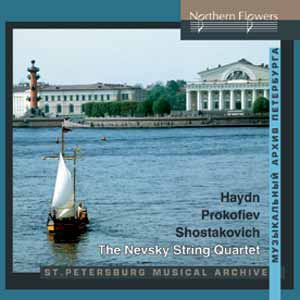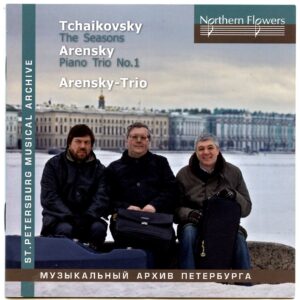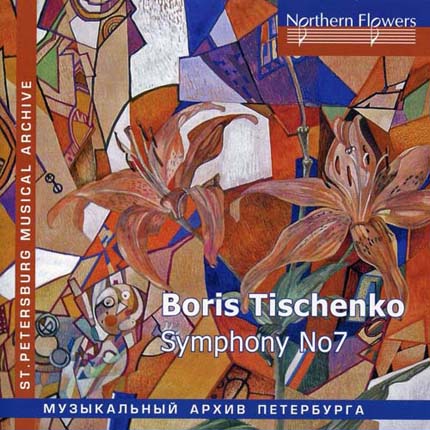Description
Recording: Anichkov Palace, St. Petersburg, February 1998 (1 – 4; 8 – 12), February 2001 (5 – 7) Recording supervision: Leonid Ribkin. Text: Northern Flowers. English text: Sergey Suslov. Design: Anastasiya Evmenova & Oleg Fakhrutdinov
| Joseph Haydn (1732 – 1809) String Quartet in g, “Reiterquartett”, Op.74 nr.3 (1793), Hob. III/74 |
||
| 1. | Allegro | 3.44 |
| 2. | Largo assai |
5.40 |
| 3. | Menuetto. Allegretto |
3.26 |
| 4. | Finale. Allegro con brio |
4.16 |
| Sergei Prokofiev (1891 – 1953) String Quartet in h, Op. 50 (1930) |
||
| 5. | Allegro |
8.42 |
| 6. | Andante molto. Vivace |
6.59 |
| 7. | Andante |
9.54 |
| Dmitry Shostakovich (1906 – 1975) String Quartet in c, nr.8, Op.110 (1960) “To the victims of the war and fascism” |
||
| 8. | 8. Largo | 4.43 |
| 9. | Allegro molto |
2.39 |
| 10. | Allegretto |
4.24 |
| 11. | Largo |
5.59 |
| 12. | Largo |
3.51 |
| Total time |
64.24 |
|
| The Nevsky String Quartet Tatiana Razumova, (violin) Svetlana Grinfeld, (violin) Vladimir Bystritsky, (viola) Dmitry Khrychov, (cello) |
||
| Recording: Anichkov Palace, St. Petersburg, February 1998 (1 – 4; 8 – 12), February 2001 (5 – 7) Recording supervision: Leonid Ribkin. Text: Northern Flowers. English text: Sergey Suslov. Design: Anastasiya Evmenova & Oleg Fakhrutdinov Haydn wrote his famous Horseman Quartet (“Reiterquartett”) in 1793. By that time, the composer had already been to London where his music was triumphantly performed; young Beethoven had become his pupil; Prince Esterházy’s ensemble had been dismissed, and Haydn had moved to Vienna composer retaining the title of Kappelmeister, a sizeable salary, and a pension. He was entering his period of impressive achievements in music, of creative freedom, and of lifetime glory that had been sought for so long.
By the Nineties of the 18th century, Haydn’s great musical ‘revolution’ was in fact completed. The genre of quartet (as well as symphony, and piano sonata) was elaborated by the composer to its classical perfection. Due to their profundity, striking musical content, and perfect form, Haydn’s quartets burst out of the narrow framework of home music–making — to become an important factor in public concretizing.
The Horseman is just one quartet of over 80 written by the great Austrian, but it is the opus where many mature composing features of the Master can be seen. The simplicity of folk–dance and folk–song tunes is matched here by amazingly masterful counterpoint intertwining of the voices and by the flawless form. The gradation of attitudes is astounding, ranging from frolic and sparkling joy to bright serenity, and sometimes to mournful or tragic intonations. On the whole, the quartet brims over with cheerfulness, optimism, ever–plentiful charge of positive energy, making it a pleasure both to its audience and performers.
The Quartet in B minor was composed by Sergei Prokofiev to the order of the Library of Congress in Washington as a contribution to the original manuscripts department. This is how the author describes this in his Autobiography: “Before setting to work, I studied Beethoven’s quartets, and that most often in a railway car, on my way from one concert to another. This study enabled me to learn and love his marvelous quartet techniques. This probably also explains a certain ‘classical’ accent of the language in the first movement of my quartet. The work has, however, two features: the final movement is slow, and the key is B minor, in which quartets are not usually written. I finished the quartet in a slow movement because its material turned out to be the most meaningful in the opus.”
Prokofiev lived in Paris, he concretized much as pianist and composer. He appeared in several triumphant performances in the Soviet Union. Little by little, the idea of coming back to his homeland grew stronger. The quartet written when still outside Russia is a surprising anticipation, in its tunefulness and inspired lyrical mood, the opuses written in mid–Thirties — already in Moscow. The first movement full of typically Prokofievan energy is indeed an example of classical style. This shows in the essence and development of the themes. The second movement, largely fast and rushed, is a kind of emblem of the virtuosity concept in the quartet. The slow finale, which is among the most perfect compositions of Prokofiev, may be compared to the most inspired and fascinating episodes in the ballets Cinderella and Romeo and Juliet, or in the music to Eugene Onegin.
Shostakovich finished the Eighth Quartet, one of his most important and popular compositions, near Dresden in Saxony, in the summer of 1960. The composer was then working at the soundtrack for the motion picture Five Days — Five Nights. It was a co–production of film studios of the Soviet Union and East Germany. The film is about saving the treasures of the Dresden picture gallery during the World War II. By 1960, the city had not fully recovered yet after the damage of horrible British–American bombing of 1945; as to the frightening settings of German death camps, they were left fully intact. It might be due to the strong impression of what he had seen in Dresden that Shostakovich put the soundtrack aside and composed the quartet in three days.
The composer dedicated the Eighth Quartet “to the memory of victims of war and Nazism ”. But there is another dedication never mentioned in Soviet music history schoolbooks and official biographies of Shostakovich. His daughter Galina recalls that having finished the quartet, her father said, “I dedicate it to myself. “ The composer wrote a history of his life, which was primarily a history of his creative work. This is why he included elements of his previous opuses in the quartet, such as First Symphony, Lady Macbeth of Mtsensk, finale of the Second Trio, First Cello Concerto, and many others. And essentially, he reverted to his musical symbol D–S–C–H (the name Dmitri SCHostakovitch as written in German.) But this monogram appears in the Tenth Symphony or in the Violin Concerto but occasionally, while in the quartet, it is repeated 87 (!) times, bonding and cementing the entire opus from beginning to end.
Shostakovich mentioned in a letter that never had he to weep so often as during the writing of the Eighth Quartet. The deep, tragic, and still beautiful work became a real confession, a diary of the greatest Master of the 20th century.
|





